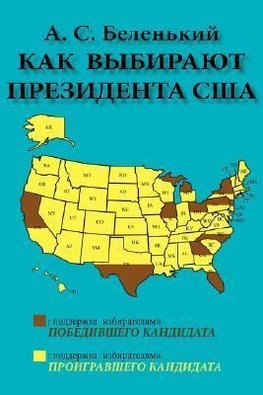
-
 Ruský jazyk
Ruský jazyk
How a President of the United States Is Elected
Autor: Alexander S. Belenky
This is the first book in Russian that describes the system of electing a U. S. President. Look at the following statements concerning U.S. Presidential elections:
1. The system of electing a U.S. President (the election...
Viac o knihe
Na objednávku, dodanie 2-4 týždne
20.07 €
bežná cena: 22.30 €
O knihe
This is the first book in Russian that describes the system of electing a U. S. President. Look at the following statements concerning U.S. Presidential elections:
1. The system of electing a U.S. President (the election system) was never designed to service the popular will.
2. The currently existing election system does not follow some major ideas of the Founding Fathers.
3. Certain election rules are such that if they were to be applied, an intervention of the U.S. Supreme Court in the election being in progress would be almost inevitable.
4. Amendment 12 of the U.S. Constitution contains at least six puzzles relevant to U.S. Presidential elections with answers that have remained unknown for more than 200 years.
5. The text of the U.S. Constitution contains a mathematically incorrect clause.
6. Skillfully using the election system may allow a U.S. Presidential candidate to win the U.S Presidency with, for instance, less than 30% of the nationwide popular vote.
7. The application of some of the election rules can lead to a constitutional crisis in the country.
8. When Americans cast their votes in U.S. Presidential elections, they do not vote for President or for Vice President, despite what they may see on the ballots or on the voting machines.
9. The "winner-take-all" principle does not encourage U.S. Presidential candidates to fight for each and every vote in a state or in DC.
10. Many statements about the Electoral College mechanism aimed at substantiating its presence in the election system, including those in the government publications, are no more than myths of their authors, no matter how plausible these myths may seem.
11. An electoral tie in the Electoral College may be resolved not necessarily in favor of a person voted for as President who has support from at least 26 delegations in the House of Representatives.
12. There is no need to abolish the Electoral College mechanism in order to make every cast vote valuable in deciding the election outcome.
If these statements have drawn your attention, and you are interested in finding explanations, this book is written for you, and you will find these explanation in it.
The system of electing a U.S. President (the election system) is very logically designed. This system has existed for more than 200 years, and many of its basic principles and conceptions have remained unchanged. Numerous attempts to make changes in these principles or even replace this system with a more understandable direct popular election system have so far failed. At the same time, some changes that have been made in the initial design of the system have engendered logical flaws in certain election rules and have made these rules fuzzy. These fuzzy rules are not given much attention in the media, since, under the existing two major party political system in the country, U.S. Presidential elections are usually decided in the Electoral College.
Many proponents of the Electoral College mechanism try to substantiate this mechanism by claiming that the existing election system reflects ideas of the Founding Fathers embedded in the U.S. Constitution. However, the election system that was meant by the Founding Fathers and the election system that is currently in use are two substantially different election systems though both of the them employ the Electoral College mechanism.
The existing election system and a direct popular system of electing a U.S. President (if it were introduced) would produce the same election outcomes only in a narrow spectrum of possible developments
- Vydavateľstvo: AuthorHouse
- Rok vydania: 2008
- Formát: Paperback
- Rozmer: 229 x 152 mm
- Jazyk: Ruský jazyk
- ISBN: 9781434354679

 Anglický jazyk
Anglický jazyk 


 Nemecký jazyk
Nemecký jazyk 








 Španielsky jazyk
Španielsky jazyk